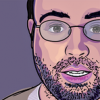-
Posts
37 -
Joined
-
Last visited
Profile Information
-
Gender
Not Telling
Recent Profile Visitors
1,267 profile views
-
 ProducerBoy reacted to a post in a topic:
Affinity V2 Suite, 2.4.1 Updates (off topic conversation split)
ProducerBoy reacted to a post in a topic:
Affinity V2 Suite, 2.4.1 Updates (off topic conversation split)
-
 ProducerBoy reacted to a post in a topic:
Affinity V2 Suite, 2.4.1 Updates on All Platforms
ProducerBoy reacted to a post in a topic:
Affinity V2 Suite, 2.4.1 Updates on All Platforms
-
 unni reacted to a post in a topic:
Brush in Overlay Mode
unni reacted to a post in a topic:
Brush in Overlay Mode
-

Brush in Overlay Mode
ProducerBoy replied to Glenar's topic in Pre-V2 Archive of Desktop Questions (macOS and Windows)
I've tried many times to paint in white or black on a mask with Overlay blend mode for precisely the reasons stated above. I'm glad for the workaround using the "mask alpha," but it would be really fantastic to be able to paint directly on a mask layer in white or black with the Overlay blend mode. -
I have an image here: https://d.pr/f/ajmR49 It has several layers that use perspective active layers. When I resize the document to width 825 (which is the size I need for the printer), the layers with perspective applied don't get properly resized and positioned. Open the file at https://d.pr/f/ajmR49 . Do Document | Resize Document… and enter 825 as the width (let the height auto-calculate). The floating windows get all screwed up. Backing up in the history prior to the resizing does not correctly restore the locations of the floating window layers. sr9-multiverse-astronomy-constellations-evening-1564312.afphoto
-

Refine Selection Preview disappears
ProducerBoy replied to klapsimo's topic in V1 Bugs found on macOS
Thank you thank you thank you @klapsimo! I was having this same problem. Adding Affinity to POPCLIP's Excluded Apps solved the problem beautifully. -
 ProducerBoy reacted to a post in a topic:
Refine Selection Preview disappears
ProducerBoy reacted to a post in a topic:
Refine Selection Preview disappears
-

StudioLink & Personas
ProducerBoy replied to Ralph's topic in Pre-V2 Archive of Desktop Questions (macOS and Windows)
Updating to 1.7.1 for all apps, then opening Photo and Designer and accepting the new ToS seemed to fix everything. -

StudioLink & Personas
ProducerBoy replied to Ralph's topic in Pre-V2 Archive of Desktop Questions (macOS and Windows)
I'm in the same boat. I own all 3, but Affinity Publisher doesn't seem to see Designer or Photo. I have no idea how to get these to work together. -
 Fotoloco reacted to a post in a topic:
Select color range
Fotoloco reacted to a post in a topic:
Select color range
-
 Rhuantavan reacted to a post in a topic:
Select color range
Rhuantavan reacted to a post in a topic:
Select color range
-
Awesome, thanks! This really clarifies things (and shows some puzzling UI choices: X for "start" instead of "abort" etc.) The V happens in the Node tool when hovering over a bezier handle. When clicking it, it seems to turn the node the handle is attached to into a sharp corner with one curved side and one straight side.
-
I've noticed when I use the pen tool, the mouse cursor changes to indicate ... something. Sometimes there's a little X down below the pen nib, sometimes there's a V-shaped thing, sometimes there's a slash, sometimes there's a circle, and sometimes there's nothing. The circle seems to mean that I'm hovering over the starting node, and clicking will close the shape. Other than that, however, I'm stymied. What do these mysterious mouse cursors indicate?
-
 Silvia reacted to a post in a topic:
Select color range
Silvia reacted to a post in a topic:
Select color range
-
I want to upvote feature requests: 1) rasterize preserve out-of-canvas portions of the image 2) a rasterize-and-trim functionality still be available (maybe if holding down option?) to do what rasterize currently does 3) a trim to transparent/specific color (1) and (3) are such a part of my workflow that I duplicate all images before rasterizing as a workaround for (1) [but it greatly enlarges my files] and I currently export a merged image, import into Pixelmator and use Trim Canvas, then take the trimmed dimensions back into Affinity to get effect (3). It's an absurd workaround but it's actually faster than trying to crop by hand sometimes.
-
 ProducerBoy reacted to a post in a topic:
Why is the Clip Canvas and Unclip Canvas tools so useless?
ProducerBoy reacted to a post in a topic:
Why is the Clip Canvas and Unclip Canvas tools so useless?
-
Is this correct as a step-by-step instruction? Assume you have a single layer called IMAGE. 1. Create an extra copy of IMAGE. Name it EXTRA. Hide it. 2. Select layer IMAGE 3. Select the foreground object using the selection brush, or channels + dodge/burn, etc. 4. Use *Refine Edges* to refine it, output to *Selection* 5. Press *Cmd+J* to create a floating foreground object 6. Re-select IMAGE 7. Press *Cmd+Sh+I* to invert the selection 8. Press the Mask Layer button to mask out the foreground object 9. *Add Live Filter > Box Blur* (or whatever else you want) and blur IMAGE, Preserving Alpha 10. You may now have a transparency halo where the foreground and IMAGE meet 11. Show EXTRA and drag it behind IMAGE. It will show through those transparency places You should now have a nice, smooth separation between foreground and background. It will look like this: * FOREGROUND OBJECT * IMAGE LAYER * MASK CREATING FOREGROUND-SHAPED HOLE IN IMAGE * BLUR EFFECT LAYER * UNALTERED COPY OF IMAGE
-
 IndigoMoon reacted to a post in a topic:
Select color range
IndigoMoon reacted to a post in a topic:
Select color range
-
I second this request. Select Sampled Color just isn't good enough. I need to be able to select a band of colors on the hue spectrum, not just a single color. Photoshop has this capability, and the HSL slider in Photoshop even allows the HSL shift to be applied to just a subset of the hue spectrum. It's a huge time saver!
-
 ProducerBoy reacted to a post in a topic:
How can I use a fill layer as a mask?
ProducerBoy reacted to a post in a topic:
How can I use a fill layer as a mask?
-
 ProducerBoy reacted to a post in a topic:
How can I use a fill layer as a mask?
ProducerBoy reacted to a post in a topic:
How can I use a fill layer as a mask?
-
 ProducerBoy reacted to a post in a topic:
How can I use a fill layer as a mask?
ProducerBoy reacted to a post in a topic:
How can I use a fill layer as a mask?
-
I've been trying to do non-destructive dodge/burn in CMYK mode, too, and the grey fill + overlay technique doesn't work. Has anyone found a way to do non-destructive dodge-burn in CMYK? It seems like this should be doable somehow. Affinity is pretty good at making things possible, if sometimes a bit obscure.


.thumb.jpg.2ac1b0424a6896c349d3d16eea40c7f3.jpg)



